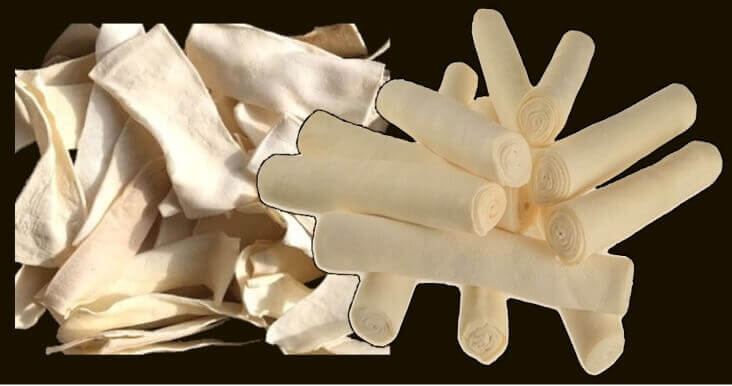All Golden Retriever owners know that they are chewers. The health of their teeth and gums are very much dependent on what they are given to chew on, daily. Over the years, we have tried many different chew treats with some very good experiences and some not so good. Many years ago, we also learned that if you do not provide your Golden something to chew on to exercise and stimulate its teeth and gums, it will find something convenient to chew on its own – like your shoes, the dining room table or chair legs, corner molding on the walls… oh yeah, they are pretty resourceful when it comes to chewing. But also, they are not so thick headed or stubborn when it comes to chew treat preferences and as long as you give them something, they will pretty much leave your valuables alone.
When a Golden Retriever chews on something, they are actually cleaning their teeth and stimulating their gums and without this, their teeth and gums would become unhealthy in a short period of time. It’s also extremely important to note that giving your Golden a constant supply of chew treats is not enough to maintain healthy oral hygiene. We strongly recommend that you have your Golden’s teeth professionally cleaned AND polished once a year. If you notice brown plaque forming on the teeth around the gum lines or redness and swelling of the gums, then more frequent cleaning may be required. Just like humans, every Golden has different requirements for their teeth and some build up plaque and tarter much faster than others. But the most important thing to remember is that the health and hygiene of your Golden’s teeth and gums will have a direct effect on their overall health and ultimately, the length of their lifespan. Teeth cleanings can be done by your veterinarian, and will require anesthesia (see our article on, “Anesthesia: What You Should Know for Your Golden Retriever”).
So now the question is, “What is a good chew treat choice for your Golden?” Although there are some out there who will disagree with us, we whole heartedly believe the plain beef rawhide rolls or chips like the ones shown in the picture at the top of this article are an excellent choice. We have used these for many years for all of our Goldens and have never had a single incident or problem. And, our Goldens absolutely love them, even more than their food! So, what are the objections that some people have with rawhides? Well, it usually has something to do with the origin of the cow hides, the possibility of contaminations, or the fear that a hard piece of the hide will be swallowed and possibly cause damage to the dog’s digestive track. We think the origin is fairly important and is the most likely case where contamination occurs. For example, if you see a glue like substance on the rolls where it looks like it is being used to perhaps bind or keep the roll together, this is probably a good indication the product origin came from China. Is this bad? It’s not necessarily a sign of contamination, but it’s not good that a rawhide roll or chip contains additives or binders and we’ll explain why next.
The objection with rawhides causing damage to the digestive track seems a bit strange to us, unless it is because the rawhide is different than what we are recommending. For example, we do not recommend the “pencil” or “stick” sized rolls, or the “twisted” rolls, or “braided” rolls; just the flat rawhides rolled into a 1-1/2” to 2” diameter roll by 9” to 11” in length. No chicken, pork or other flavoring, just plain white beef rawhide. If you stay with our recommendations and avoid the others choices, we think all the objections quickly disappear. But let’s now talk more about the possibility of damage to your dog’s digestive track if a hard piece of the rawhide is swallowed whole. To better understand this, it might help to know a little about how the rawhide chews are made.
The way rawhide chews are made is as follows: the cow skin is dehaired, degreased, desalted and soaked in water for a period of 6 hours to 2 days. At this stage the hide becomes very soft, pliable, and limp almost like a piece of velvet cloth, yet strong and tear resistant. Then the hide is wrung out and while still slightly damp, the hide is cut into strips and then rolled (for roll products), or laid out flat (for chip products), and then completely dried out in temperature controlled rooms where the soft pliable texture becomes hardened and rigid.
The final products that we recommend though hardened, are not brittle and susceptible to breaking into smaller pieces. As your dog chews on the rawhide and it mixes with saliva, it again begins to soften back into a velvety-like substance that is easily torn, chewed, and swallowed. But the “pencil” or “stick” sized rolls, or the “twisted” rolls, or “braided” rolls all have a greater chance of breaking off while still hard before they have a chance to soften by the dog’s saliva. That is why we avoid those products. For the past 10 years, we have been giving our Goldens the plain beef rawhide chews on a daily basis which has helped them maintain healthy teeth and gums, and not a single problem with digestion.
We hope this article has helped you to develop your thoughts about giving your Golden Retriever beef rawhide chews and as always, thank you for considering Emery-n-Denise’s Golden PuppiesTM.
We are exclusively a Golden Retriever Breeder of AKC pure bred Golden Retrievers and we have Golden Retriever Puppies For Sale in Massachusetts and Maryland.

